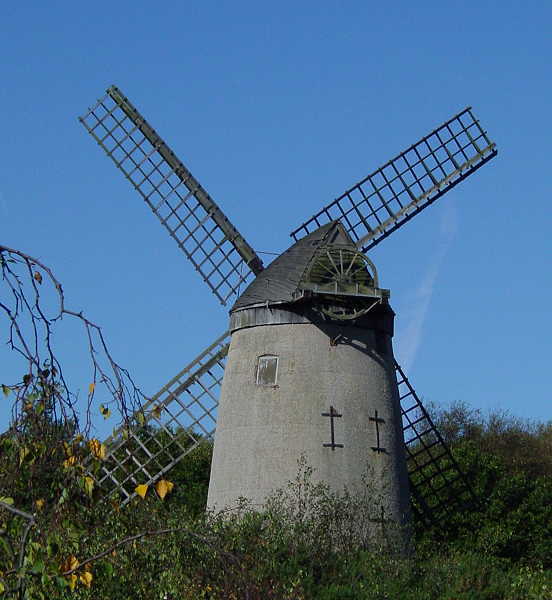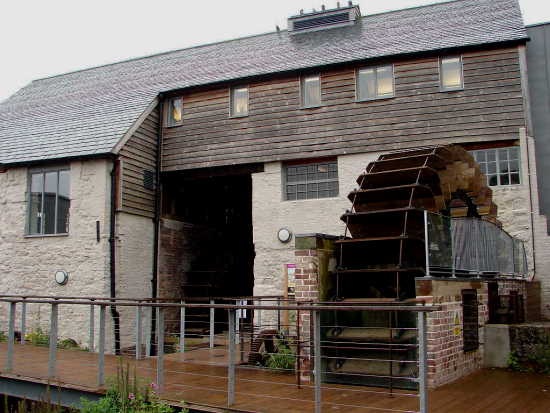A mill may be a factory for certain kinds of manufacture, as paper, steel, or textiles. This mill in Chorley was part of the cotton manufacturing industry that made South Lancashire and the port of Liverpool so rich in days gone by.
A mill is also a building equipped with machinery for grinding grain into flour and other cereal products. These sort of mills may be water mills or windmills.
This disused windmill is at Bidston on The Wirral, quite near where I live.
The rest of my photos are all watermills like the Norse Iron Age Mill and Kiln - Shawbost - Isle of Lewis - Western Isles
This mill at Dedham in Essex was made famous in Constable's paintings.
Cricklepit Mill, Exeter, Devon.
Rosset Mill, Cheshire.
Mills have machinery and millstones and millwheels... This mill at Otterton in Devon was made famous by Daughter-who-takes-photos marrying Son-in-law-and-friend-who-loves-otters last year!
Going around dusty mills can make you thirsty so near to us we have the Irby Mill inn.
And I shouldn't forget Miss Millicent Brookes, a distant cousin of mine, though I have to admit it's not one of my photos!!
If you would like to see what other Wednesday folk have chosen for the letter M please visit...


















.png)




















































Love the photos of the mills! The Dedham Mill in Essex is one of my favourite places. There are some beautiful walks along the river and across the water meadows there. Plus, the visitors' center and gift shop has a lovely tea room! (If we're going somewhere new, one of the first things Robin checks in the guidebook is whether or not there is somewhere nearby where we can have a cup of tea. The army may march on its stomach, but Robin requires tea!)
ReplyDeleteAnother lovely posting. xoxo Carol
What are those two structures that looks like just roofs and no walls? and bags of stones? to keep the roof so the wind won't blow it away?
ReplyDeleteHello Ann - they are thatched buildings. In this case a thousand year old mill (except it's a rebuilt one not an original). The walls are very low and the roof, usually based on wooden beams, is what gives the interior its height. Because of the high winds the thatch is kept on by a form of netting weighed down with stones. You can see the inside of a similar structure on my Hebridean Blog here.
ReplyDelete(Ironically I nearly did M for Mosses like you today.)
Until now, I didn't know that mills already existed in the Iron Age. Thank you for constantly giving me new things to learn!
ReplyDeleteWhat an impressive building in the first picture !
ReplyDeleteWindmills we have a lot here too. I like all the other mills, they look so romantic !
Gattina
ABC Team
nifty medley of mills!!
ReplyDeleteROG, ABC Wednesday team
Beautiful windmills!
ReplyDeleteLittle MISSES
Rose, ABC Wednesday Team
You have really captured some mills here John (See I have been checking your profile again!)
ReplyDeleteYou'll find some lovely photos of Dedham Mill and Constable Country on my blog under Essex if you are so inclined.
well, you certainly enlightened me about mills! I had no idea there were so many different kinds. I must admit that the image I have in my head is either a watermill or the windmills in Holland. wonderful shots!
ReplyDeleteWonderful collection of mills! The one that puzzles me is the Norse mill. I'm wondering what powers it. Obviously, I'm just being dim, so I must be misunderstanding something in the picture. I must say I'm surprised that there are any disused windmills in such good condition these days. I wonder why its owner isn't selling it for a fortune to someone who wants to convert it into an unusual holiday home!
ReplyDeleteJenny, the Norse mill was powered by a stream which, unfortunately, doesn't show up in that picture. I have one from a different angle that shows the stream but it doesn't show the whole set up of mill and forge so well.
ReplyDeleteI never think of mills but I think of Wordsworth's "dark satanic mills". I think it was Wordsworth, my senior moments get more senior all the time. Hope you make a Celtic knot.
ReplyDeleteWhoops! I had to go back and correct myself. It was William Blake in "Jerusalem".
ReplyDeleteMills provided some attractive buildings - even the Lancashire Cotton Mill which would have been a sweatshop and, by our standards, a horrendous place to work has a majestic beauty.
ReplyDeleteA great post, Scriptor! These are all the old type of mills (I wonder if they used the water mill in the UK more than the windmill). Do you have the newer type where you live (in Holland they call them also wind turbines)?
ReplyDeleteVery interesting info about mills, I've seen quite a few flour mills in the country. I like all your examples.
ReplyDeleteAnn
this is almost a technical writing piece!! very good.
ReplyDeletemessy little girl
Magnificent and marvelous mills - I'm going to be in Liverpool in August! Hopefully, will see some of this magical scenery.
ReplyDeleteLeslie
abcw team
Hi John, this is my first visit to your blog. I love it and I love your cool photo collection of mills. Reminds me of the mills I saw on my visit to Amsterdam. That's wonderful old photo of your distant cousin.
ReplyDeleteThanks so much for sharing.